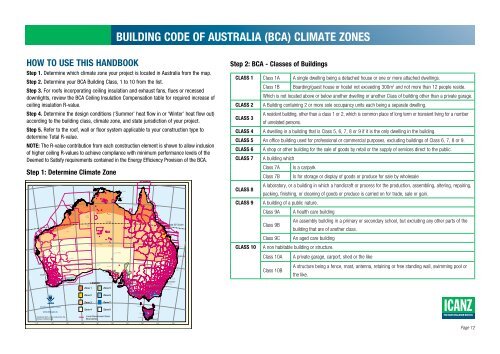INSULATION HANDBOOK Part 1: Thermal Performance - icanz
INSULATION HANDBOOK Part 1: Thermal Performance - icanz
INSULATION HANDBOOK Part 1: Thermal Performance - icanz
Create successful ePaper yourself
Turn your PDF publications into a flip-book with our unique Google optimized e-Paper software.
HOW TO USE THIS <strong>HANDBOOK</strong><br />
Step 1. Determine which climate zone your project is located in Australia from the map.<br />
Step 2. Determine your BCA Building Class, 1 to 10 from the list.<br />
Step 3. For roofs incorporating ceiling insulation and exhaust fans, flues or recessed<br />
downlights, review the BCA Ceiling Insulation Compensation table for required increase of<br />
ceiling insulation R-value.<br />
Step 4. Determine the design conditions (‘Summer’ heat flow in or ‘Winter’ heat flow out)<br />
according to the building class, climate zone, and state jurisdiction of your project.<br />
Step 5. Refer to the roof, wall or floor system applicable to your construction type to<br />
determine Total R-value.<br />
NOTE: The R-value contribution from each construction element is shown to allow inclusion<br />
of higher ceiling R-values to achieve compliance with minimum performance levels of the<br />
Deemed to Satisfy requirements contained in the Energy Efficiency Provision of the BCA.<br />
Step 1: Determine Climate Zone<br />
BUILDING CODE OF AUSTRALIA (BCA) CLIMATE ZONES<br />
Step 2: BCA - Classes of Buildings<br />
CLASS 1 Class 1A A single dwelling being a detached house or one or more attached dwellings.<br />
Class 1B Boarding/guest house or hostel not exceeding 300m2 and not more than 12 people reside.<br />
CLASS 2<br />
Which is not located above or below another dwelling or another Class of building other than a private garage.<br />
A Building containing 2 or more sole occupancy units each being a separate dwelling.<br />
CLASS 3<br />
A resident building, other than a class 1 or 2, which is common place of long term or transient living for a number<br />
of unrelated persons.<br />
CLASS 4 A dwelling in a building that is Class 5, 6, 7, 8 or 9 if it is the only dwelling in the building.<br />
CLASS 5 An office building used for professional or commercial purposes, excluding buildings of Class 6, 7, 8 or 9.<br />
CLASS 6 A shop or other building for the sale of goods by retail or the supply of services direct to the public.<br />
CLASS 7 A building which<br />
Class 7A Is a carpark<br />
Class 7B Is for storage or display of goods or produce for sale by wholesale<br />
CLASS 8<br />
A laboratory, or a building in which a handicraft or process for the production, assembling, altering, repairing,<br />
packing, finishing, or cleaning of goods or produce is carried on for trade, sale or gain.<br />
CLASS 9 A building of a public nature.<br />
Class 9A A health care building<br />
Class 9B<br />
An assembly building in a primary or secondary school, but excluding any other parts of the<br />
building that are of another class.<br />
Class 9C An aged care building<br />
CLASS 10 A non habitable building or structure.<br />
Class 10A A private garage, carport, shed or the like<br />
Class 10B<br />
A structure being a fence, mast, antenna, retaining or free standing wall, swimming pool or<br />
the like.<br />
Page 12


